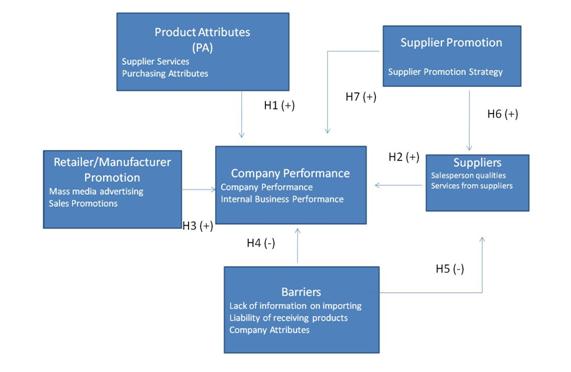By Scott Lyon, swlyon@vt.edu
A conceptual model was developed based on preliminary studies and applied to the survey of perceptions of wood products retailers and manufacturers from Central America regarding supplier attributes, product attributes, retailer/manufacturer promotion strategy, supplier promotion strategy, potential importing barriers, and company performance. Cronbach’s alpha and factor analysis were used to check the reliability and validity of the data. The results of factor analysis suggested meaningful groupings within many of the constructs, including factors such as product attributes, purchasing attributes, and supplier services. Two hypothetical models were developed and the relationships were tested for significance using ANOVA and multiple regression analyses. Barriers were found to positively affect company performance and supplier attributes. These constructs may be important to consider when Appalachian wood products companies are interested in exporting to Central American countries. Appalachian wood products companies need to invest resources and work to overcome barriers in order to be successful exporters to Central America.

Other international marketing studies were consulted to determine what attributes to consider in the survey and the conceptual model (Cossio 2007; Parhizkar 2008). The survey focused on supplier attributes, product attributes, retailer/manufacturer promotion strategy, supplier promotion strategy, potential importing barriers, and company performance.
The first hypothesized model suggested that supplier attributes would be predicted by supplier promotion and barriers (Figure 1). Although supplier promotion did not appear to be driving supplier attributes (Hypothesis 6), barriers (i.e., language barrier, quality of Appalachian wood products, transportation and logistics) was found to be a significant predictor (Hypothesis 5).
These findings of supplier promotions contradict other studies that find promotion such as personal selling to be an important supplier’s attributes (Szymanski 1988). Barriers were found to be a significant predictor of supplier attributes (Hypothesis 5). While literature suggests a negative relationship of barriers to supplier attributes, this model suggests that the relationship with barriers is positive. It is possible that suppliers may have to work harder to overcome the barriers, which, in turn, provides a positive impact on the supplier attributes. Some studies have found that companies entering a new export market need to overcome barriers (i.e. specific product design and promotion strategy). These companies have an advantage over their competition and their company performance improves by the increase of sales (Douglas and Wind 1987; Jain 1989; Cavusgil et al.1993; Cavusgil and Zhou 1994). For instance, if Appalachian wood products companies produce lumber in the dimensions required by Central American customers, then they may have competitive advantage over companies that do not produce to the desired product attributes.
The second hypothesized model suggested that company performance of Central American retailers/manufacturers was predicted by Product Attributes (Hypothesis 1), Supplier Attributes (Hypothesis 2), Retailer/manufacturer promotion (Hypothesis 3), Barriers (Hypothesis 4) and Supplier Promotion (Hypothesis 7).
Retailer/manufacturer promotion and barriers were the only constructs that significantly contributed to company performance of Central American wood products retailers/manufacturers (Hypothesis 3 and 4). Company performance was measured through a series of Likert Scale questions in the retailer/manufacturer survey. Retailer/manufacturer promotion had a positive relationship with company performance. These findings support previous research that suggests retailer/manufacturer promotion is important when marketing products to increase company sales and performance (Walter and MacKenzie 1988). Appalachian wood products companies need to adjust their promotion strategy in order to help increase the promotion strategy for Central America retailers/manufacturers and to increase their company performance. Appalachian wood products companies should provide point-of-purchase product literature, display racks, offer sales and product discounts in-order for Central American retailers/manufacturers to be successful in selling or using Appalachian wood products. Product literature and display racks from the Appalachian region should be in Spanish since this is the native language of the majority of consumers.
Barriers were found to be a significant predictor of supplier attributes (Hypothesis 4). While literature suggests it is a negative relationship with company performance, this model suggests that barriers have positive impact with company performance (Parhizkar 2008). It may be the challenge of breaking down barriers that improves company performance. Product attributes (Hypothesis 1), supplier promotion (Hypothesis 7), and supplier attributes (Hypothesis 2) did not predict company performance. These findings seem to be contradictory to other research in the field (Swan and Combs 1976; Anderson and Weitz 1992; Abad 2003).
Barriers preventing trade of products (e.g., governmental policies) were significant independent variables in both models (Hypothesis 4 and Hypothesis 5). This suggests that companies may need to invest more time and resources focusing on barriers to increase company performance and supplier attributes.
More research is needed to develop models that identify other factors predicting company performance and supplier attributes. It is possible that other items may be better predictors of company performance and supplier attributes that were not covered in this questionnaire.
Models that explain a greater proportion of the variability would help individuals and companies in the wood products industry and research sectors understand the important driving factors predicting company performance and supplier attributes. If these drivers are known, then companies in the wood products industry can develop strategies to address the areas that would improve their company performance. For example, a friendly salesperson who maintains a relationship with the customer may be an important driver for positive company performance. If companies are aware of this relationship, they can focus on this area in their strategic marketing plan. Companies may need to focus on breaking the barriers to better conduct international business.
References:
Please contact the author for a list of sources swlyon@vt.edu.
